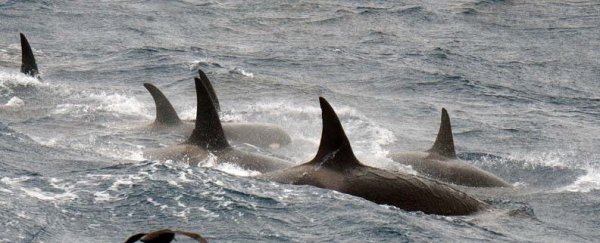
A team of conservationists travelling through the South Indian Ocean has encountered an elusive class of orca, known as the Type D, and have captured what is believed to be the first video footage.
The crew of the Bob Barker, a ship belonging to the ocean conservation organisation Sea Shepherd, encountered the pod of 13 rare orcas (Orcinus orca) on 26 December 2014 while tracking an Interpol-listed poaching vessel.
At the time of the sighting, the Bob Barker was travelling between the Crozet and Kerguelen archipelagos – some of the world's most isolated islands, some 3,000 km from the nearest permanently populated location.
"The crew watched in awe as the 13 killer whales, including a small juvenile and a large male, used the six-metre swell to surf across the bow. For almost an hour the surf-show continued and was accompanied by bow riding, tail-slaps and breaches," said Bob Barker Chief Engineer, Erwin Vermeulen, in the Sea Shepherd announcement.
The Sea Shepherd encounter was filmed and photographed, and these material were later sent to marine ecologist Robert Pitmam, who works at the Southwest Fisheries Science Centre of the US National Oceanic and Atmospheric Administration (NOAA).
According to the Sea Shepherd announcement, Pitman examined the photographs and footage and confirmed they were Type D killer whales. "I don't think they have ever been filmed alive," he added.
Type D orcas - physically different from Types A, B and C - were first identified and described in 1955 when a pod stranded on Paraparaumu Beach, New Zealand.
According to this NOAA classification chart, the Type D has a rounded head, resembling that of a pilot whale, and a tiny white eye patch. It has a circumglobal distribution in subantarctic waters (north of 60 degrees south) and has been associated with islands.
According to the Sea Shepherd announcement, this type of orca was not seen again for almost 50 years after the New Zealand stranding, and this is believed to be only the 13th sighting.
Researchers from the University of Copenhagen analysed DNA from one of the stranded whales (it's skeleton had been preserved in a museum in Wellington) and compared it to samples from 139 other killer whales. They estimated that the Type D diverged from other orcas roughly 390,00 years ago, making it the second oldest branch in the orca family.
Their results were published in June 2013 in Polar Biology.
According to the NOAA, killer whales are the most widely distributed marine mammals on earth, and are generally considered to belong to a single species.
However, genetic studies, as well as evidence describing unique physical features on different pods of whales in different regions, has led biologists to consider the existence of several different sub-species, or new species altogether.
The International Union for the Conservation of Nature suggested in a 2008 report that the taxonomy of the orca is "in need of review", and that in coming years it will likely be split into a "number of different species".
According to Seaworld's website, at least 10 killer whale ecotypes are currently recognised. These whales may "have overlapping geographic ranges… but have slight genetic differences and distinct differences in size, habitat, colour pattern, dorsal fin shape, vocalisations, diet, and hunting strategies".
SOURCE: Discovery News
